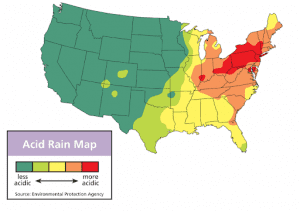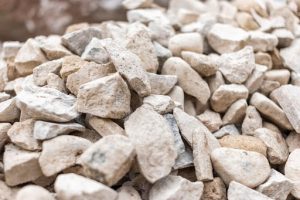What is Acid Rain?
Acid rain, also called acid deposition, is a broad term that involves any form of precipitation with acidic properties.1 This includes rain, snow, fog, hail, and even dust. The components of acid rain are sulfuric and nitric acid.1
Forms of Acid Rain
Acid rain can come in two forms: wet and dry. In wet form, acid rain can be rain, snow, fog, or hail. Dry acid rain consists of particles and gas.1 Dry acid rain lands on surfaces pretty quickly and reacts during atmospheric transport to form larger particles that can be harmful.1
Causes of Acid Rain
Acid deposition is the result of sulfur and nitrogen oxides being emitted into the atmosphere and transported by wind and air currents.1 A small portion is caused by natural resources such as volcanoes that release pollutants into the air.
Most acid deposition comes from the burning of fossil fuels used to generate electricity.1 Two-thirds of sulfuric acid and one-fourth nitric acid come from electric generators.1 Acid deposition can also come from vehicles and heavy equipment.1 It also results from manufacturing, oil refineries, and a multitude of industries.1
The pH of Acid Rain

The acidity of rain, like many other substances, is measured on the pH scale. The normal acidity of rain is around 5.6 on the pH scale which is only slightly acidic.1 When precipitation mixes with sulfur and nitrogen oxides the acidity is between 4.2-4.4.1
Consequences of Acid Rain
Unfortunately acid deposition can cause damage to a range of environments, humans, and even man made surfaces and different materials.
Fish and Wildlife

The effects of acid rain are most easily seen in aquatic environments. As acid rain passes through soil it filters aluminum from clay particles into lakes and streams.1 Some animals are able to tolerate this process. They do not suffer because certain area soil can buffer the rain by neutralizing its acidity. This depends on the soil’s thickness and composition.
Other animals cannot tolerate the acidic waters and are lost as the acidity increases.1 This is especially detrimental to juvenile wildlife as they are more sensitive to this acidity than adults. With higher acidities most fish eggs won’t hatch. Many times, wildlife who can tolerate the increase in acidity are still lost because they eat animals that cannot.1 The decrease in their food source causes starvation.

Nitrogen pollution is one of America’s most widespread and challenging environmental issues and can be a by-product of acid rain.1 In coastal waters, it is partly responsible for the decline in fish and shellfish populations. Too much nitrogen in water can cause algal blooms, decreasing oxygen supplies and increasing elevated toxins and bacterial growth.1
Plants and Trees

Acid rain can remove the minerals and nutrients from soil that trees and other plants need to grow.1 It can strip the nutrients from vegetation foliage. This in turn causes stunted growth and exposure to other air pollutants.1 Acid rain can also strip away a plant’s ability to combat cold and disease.2 This loss of nutrients is shown by brown leaves, eventually leading to the plant’s death.
Materials

Acid rain has also been known to cause damage to materials. It can corrode metal and cause paint and stone to deteriorate quicker.1 It can also cause loss of detail on statues and monuments.1
Human Health
When in direct contact with acid deposition, such as walking or swimming in it, there is a near-zero chance of it causing someone harm.1 It is the air pollutants that come from acid deposition(sulfur, nitrogen) that can cause problems when inhaled.
Acid deposition pollutants can cause difficulty breathing, especially for people with asthma.1 It can also cause heart attacks for people with increased heart disease risk.1
Possible Solutions
Over the years, there have been many mitigation strategies being used to combat the effects of acid deposition. One strategy that is used is scrubbing. Scrubbing is the term used to describe chemically eliminating sulfuric deposition from the gas leaving smokestacks (chimneys used to discharge smoke from industrial buildings and vehicles).3 This process can eliminate up to 95% of sulfuric gas.3

The industry has also been shifting to using fuels that emit less sulfuric acid in production. Catalytic converters, devices that are fixed onto the exhaust pipes of motor vehicles, are also used to reduce nitric acid emissions.3

Lime has become an important resource in trying to fight the effects of acid rain. Lime is a mineral placed into acidic waters to balance the acidity.3 Unfortunately, lime is an expensive resource to try and get and it is only a short-term solution in trying to balance acidic waters.3 It is a method that has to be done repeatedly in order to see results.
Finally, the industry is starting to use alternative sources of energy in order to limit the effects of acid rain. With the main alternatives being wind and solar energy, industries are also turning to geothermal, hydrothermal, and nuclear energy to power industrial buildings and locomotives.3
In recent years, it seems that there has been a serious decline in the problems acid rain can cause in North America but as it becomes an increasing phenomenon in other countries, it doesn’t seem to be an environmental issue that will ever be completely eradicated.
Sources
1.“What is Acid Rain?” United States Environmental Protection agency, https://www.epa.gov/acidrain/what-acid-rain
- Franco, Antanica. “Acid Rain Effects on Plants and Animals.” Sciencing, 24 May 2019, https://sciencing.com/acid-rain-effects-plants-animals-6326371.html
3. “Acid Rain: Causes, Effects, and Solutions to Increase the pH Level.” Conserve Energy Future, https://www.conserve-energy-future.com/causes-and-effects-of-acid-rain.php








